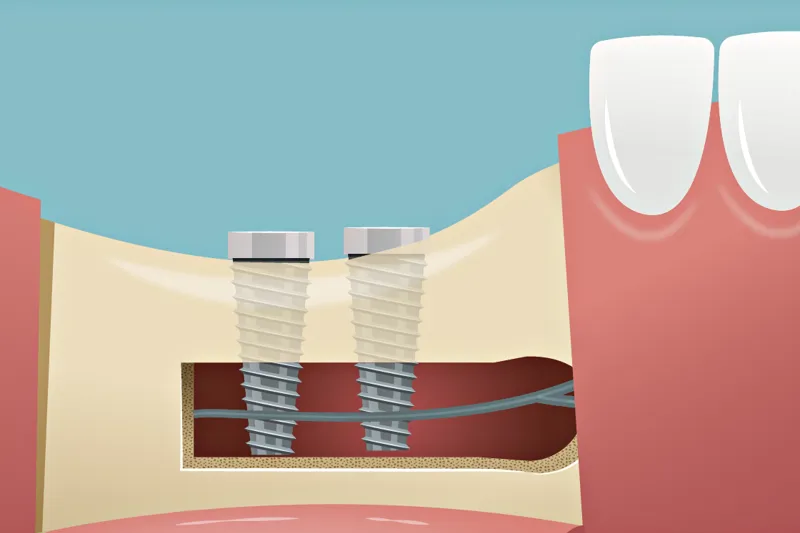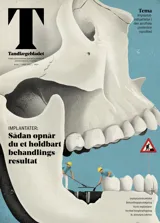Lateralisering eller transposition af n. alveolaris inferior i forbindelse med implantatindsættelse i den atrofiske posteriore mandibel
I nærværende oversigtsartikel præsenteres den nuværende viden om lateralisering og transposition af n. alveolaris inferior i kombination med samtidig indsættelse af standardlængdeimplantater i den atrofiske posteriore mandibel, og de kirurgiske procedurer illustreres.

Implantatindsættelse i den svært atrofiske posteriore mandibel kan indebære en risiko for intraoperativ beskadigelse af n. alveolaris inferior som følge af reduceret afstand mellem toppen af processus alveolaris og den øvre begrænsning af canalis mandibulae. Lateralisering eller transposition af n. alveolaris inferior i kombination med samtidig implantatindsættelse kan derfor være en behandlingsmulighed, når højden af processus alveolaris ikke tillader protetisk rekonstruktion med korte implantater eller vertikal knogleopbygning med sandwichosteotomi og forsinket implantatindsættelse. Systematiske oversigtsartikler har vist høj implantatoverlevelse og begrænset periimplantært marginalt knogletab i forbindelse med lateralisering og transposition af n. alveolaris inferior. Imidlertid er denne behandling forbundet med risiko for alvorlige komplikationer, herunder fraktur af mandiblen, tab af sensibilitet i tænderne anteriort for foramen mentale samt temporære og permanente neurosensoriske forstyrrelser svarende til hagens hud og underlæbe.
I nærværende oversigtsartikel præsenteres den nuværende viden om lateralisering og transposition af n. alveolaris inferior i kombination med samtidig indsættelse af standardlængdeimplantater i den atrofiske posteriore mandibel, og de kirurgiske procedurer illustreres.
Klinisk relevans:
Implantatindsættelse i den atrofiske posteriore mandibel kan være umulig som følge af reduceret afstand fra toppen af processus alveolaris til den øvre begrænsning af canalis mandibulae. Indsættelse af korte implantater, sandwichosteotomi og lateralisering eller transposition af n. alveolaris inferior (LTNAI) er de hyppigst anvendte kirurgiske teknikker til protetisk rehabilitering af den atrofiske posteriore mandibel. Imidlertid er LTNAI forbundet med højere frekvens af intra- og postoperative komplikationer sammenlignet med indsættelse af korte implantater eller sandwichosteotomi. Implantatindsættelse i forbindelse med LTNAI kan derfor kun anbefales, når højden af processus alveolaris ikke tillader protetisk rekonstruktion af den atrofiske posteriore mandibel med korte implantater eller sandwichosteotomi.Lateralization or transposition of the inferior alveolar nerve in conjunction with implant placement in the atrophic posterior mandible
Placement of dental implants in the severely atrophic posterior mandible may involve a risk of intraoperative injury of the inferior alveolar nerve due to a reduced distance between the top of the alveolar crest and the mandibular canal. Lateralization or transposition of the inferior alveolar nerve in conjunction with simultaneous placement of implants is therefore considered a treatment option when the height of the alveolar ridge does not allow prosthetic reconstruction with short implants or vertical bone augmentation with sandwich osteotomy and delayed implant placement. Systematic reviews have revealed high implant survival and limited peri-implant marginal bone loss following lateralization or transposition of the inferior alveolar nerve. However, this treatment is associated with risk of serious complications involving mandibular fracture, loss of sensitivity of the teeth anterior to the mental foramen as well as temporary or permanent neurosensory disturbances of the chin and lower lip. In the present review, the current knowledge on lateralization or transposition of the inferior alveolar nerve in conjunction with simultaneous placement of standard-length implants in the atrophic posterior mandible is presented and the surgical procedures are illustrated.


